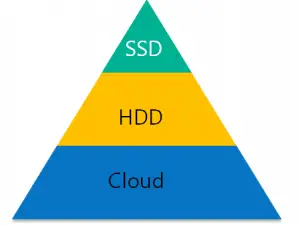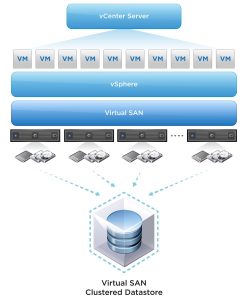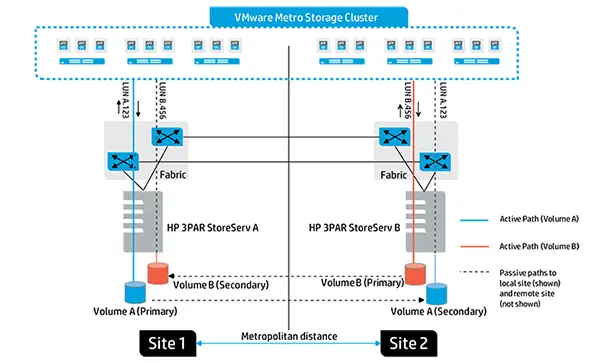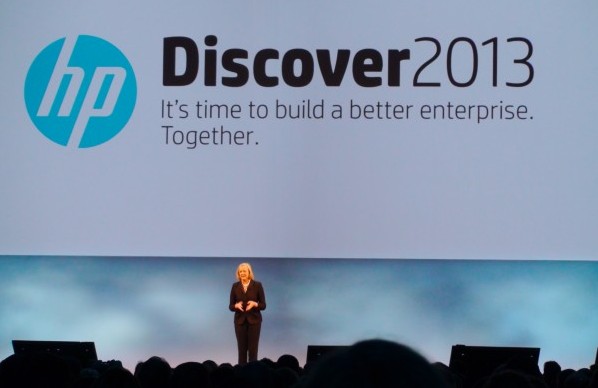Dealing with astronomical data growth is a problem that every business, small to large, is dealing with. Data is expected to grow from about 4.4 trillion gigabytes to over 44 gigabytes by the end of this decade according to numbers reported by IDC this year. But of all the data captured and created, most of it sits idle just a few days after its initial creation, never to be referred to again. So, how do businesses combat this?
 Microsoft’s Marc Farley offered one Microsoft solution during his session, The StorSimple Approach to Solving Issues Related to Growing Data Trends. Utilizing StorSimple, a Microsoft owned company, businesses can implement a third tier of storage in the cloud. But storing data in the cloud comes with its own set of challenges. The folks behind StorSimple recognized that most data in the cloud is stored in objects – not file and block like traditional datacenter data. Moving data back and forth between the cloud presents problems because you have to change the data type from file or block into objects going into the cloud and from objects back to file or block from the cloud. StorSimple is a solution to that problem by natively storing the data in object stores locally and providing companies with the ability to transport these objects into the cloud for backup, archive and off-site storage all the while providing applications with fast access to the data on-premise.
Microsoft’s Marc Farley offered one Microsoft solution during his session, The StorSimple Approach to Solving Issues Related to Growing Data Trends. Utilizing StorSimple, a Microsoft owned company, businesses can implement a third tier of storage in the cloud. But storing data in the cloud comes with its own set of challenges. The folks behind StorSimple recognized that most data in the cloud is stored in objects – not file and block like traditional datacenter data. Moving data back and forth between the cloud presents problems because you have to change the data type from file or block into objects going into the cloud and from objects back to file or block from the cloud. StorSimple is a solution to that problem by natively storing the data in object stores locally and providing companies with the ability to transport these objects into the cloud for backup, archive and off-site storage all the while providing applications with fast access to the data on-premise.
StorSimple is an iSCSI storage appliance that combines traditional hard disks with solid state to offer fast storage performance for applications. It uses a queuing technique to store all incoming data as quickly as possible and then uses a ‘spill-over’ technique to move them down to lower tiers of storage. It keeps primary data on the HDD and SDD and then utilizes cloud object stores to create snapshots of the data for backup, archive and off-site retention. StorSimple uses SSD to ingest the data a quickly as possible and then uses dedupe and compression to make better utilization of space on the hard drive and cloud tiers of storage.
Traditionally, businesses have utilized tape for the purposes of backup, archive and off-site storage, but tape comes with its own set of challenges. Marc talked a bit about the challenges of backup and especially backup to tape in business environments – from tracking cartridges to operational challenges of locating and off-siting tapes.
But in addition to the backup, recovery and archive data, what happens when a company runs out of hard disk space in an array? Interestingly, StorSimple utilizes the cloud as another layer of spill over for stale data that will likely never be recalled again. That is a unique take to solving the increasing storage demands for businesses.
In terms of management, StorSimple brings all the functions of primary and backup storage into a single appliance and, more importantly, into a single management interface where all the functions are managed together – rather than in different silos by different administrators. This allows for administrators to have an unified view of their storage.
Living up to the ‘simple’ part of its name, StorSimple is a straight forward solution that doesn’t necessarily offer some of the high availability features that other storage platforms include. The hardware is fully redundant, but there aren’t clustering features built into the platform, although disaster recovery to another site is possible using the cloud transport between the two combined with policies that dictate the recovery time objectives and recovery point objectives.
Find out more at www.storsimple.com or get a copy of Marc Farley’s book Rethinking Enterprise Storage: A Hybird Cloud Model.
 For the next week, I really want to try and give the Elitebook Folio a good run through and the only way for me to do this for sure is to leave my Mac behind. I’m writing this post on the new Elitebook and I can already feel many similarities between it and my Mac. The keyboard is very familiar to a Mac user. The display is great in terms of resolution and brightness. The trackpad is different – enough so that HP packages a how-to video about the trackpad, but as a Mac user I do miss multi-touch jestures. When I unpacked the Elitebook, I was very impressed with how lightweight but sturdy the hardware felt. I promise a full review of the hardware after I’ve given it a solid test.
For the next week, I really want to try and give the Elitebook Folio a good run through and the only way for me to do this for sure is to leave my Mac behind. I’m writing this post on the new Elitebook and I can already feel many similarities between it and my Mac. The keyboard is very familiar to a Mac user. The display is great in terms of resolution and brightness. The trackpad is different – enough so that HP packages a how-to video about the trackpad, but as a Mac user I do miss multi-touch jestures. When I unpacked the Elitebook, I was very impressed with how lightweight but sturdy the hardware felt. I promise a full review of the hardware after I’ve given it a solid test. HP announced its
HP announced its 
 Almost two weeks ago now, VMware unwrapped vSphere 5.5 to the public. The release, which ships later this year, includes a lot of enhancements and some new features for the datacenter. I won’t lie – 5.5 has a lot more in it for the datacenter than 5.1 enhancements. And I left VMworld 2013 much more excited about the direction of the virtual datacenter than I did at the end of VMworld 2012. So what are the things that sys admins will really care about in vSphere 5.5?
Almost two weeks ago now, VMware unwrapped vSphere 5.5 to the public. The release, which ships later this year, includes a lot of enhancements and some new features for the datacenter. I won’t lie – 5.5 has a lot more in it for the datacenter than 5.1 enhancements. And I left VMworld 2013 much more excited about the direction of the virtual datacenter than I did at the end of VMworld 2012. So what are the things that sys admins will really care about in vSphere 5.5?



